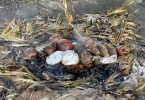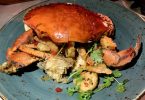The morning heat in our Avignon hotel room is palpable. I open the window and feel the gush of a cold breeze. Although the sun is out, there is an unusual chill in the air. After a breakfast of croissants, jus d’orange, cafe au lait and a selection of confitures, fromages and yoghurt, we settle our account and leave a place that made us feel like our country home. We bid bonne route and take the direction of Avignon.
Or so we think.
After circling zone industrielle and centre ville, after taking every possible exit at every roundabout, we stop at a service station to refuel and buy a map of Avignon and the 60 km region around Montpellier and Perpignan. I ask the girl behind the counter to indicate our location and I start to cringe. We are way off our destination.
This time, with the aid of a detailed map, we reach the papal town. Avignon lies in the heart of Vaucluse, on a privileged site sheltered by a towering cliff overlooking the Rhone river. The fourteenth century gave it an air of glory when the popes who were forced out of Italy settled there for more than a century. Clement V was the first pope who reigned Avignon followed by Jean XXII, Avignon’s former bishop who enlarged the palace; Benoit XII; Clement VI who bought the city for the queen Jeanne, countess of Provence in 1348; Innocent VI, Urbain V and Gregoire XI who returned the papacy to Rome. During the sixteenth century, the town weakened and did not prosper until the eighteenth century when its industry blossomed. It long remained in the possession of the popes until its annexation by the national assembly in 1791 during the French revolution.
There is a strong wind propelling us towards Rocher des Doms, a public park offering magnificent views of the Rhone.
“I wonder if this is the Mistral” I say in jest.
The Mistral is a gusty and forceful wind that typically blows down the Rhone valley, often arriving unannounced and accompanied by a clear, sunny sky. It takes its name from the old provençal language, maestral, and is often blamed for driving people mad and causing them to commit crimes passionels. Frederick Mistral, a French poet who commemorated Provence in his works, took his name from the mistral wind. He also created the character of Mireio, Mary of the sun, known in more recent times as Mireille, a popular name in this region.
The only crime of passion I want to commit is if I don’t remain upright in the wind.
Pont-St-Benezet: Le Pont d’Avignon
And there it is, on the banks of the Rhone river in its old stone glory. Pont-St-Benezet otherwise known as Le Pont d’Avignon, is the bridge on which the famous children’s nursery rhyme is based. Built in 1176 by the local shepherd Benezet, the arched bridge partly washed away after a storm, was broken and repaired at various times until finally abandoned in 1680. Only four arches remain and one of them houses the Romanesque sixteenth century chapel of Saint-Nicholas.
The sight of the bridge evokes childhood memories. In my mind, I sing the nursery rhyme, do a little dance and take a trip back in time.
Sur le pont d’Avignon
l’on y danse, l’on y danse
Sur le pont d’Avignon
l’on y danse tous en rond.
In the meantime, the Mistral is hurling me towards the river as I stand on uneven ground. I want to ascend the bridge to sing and dance like a little girl but it is looking unsafe by the minute.
We return towards Palais des Popes, the all-in-one fortress, church and palace. Built from 1334 to 1352 under the pontificates of Benedict XII and Clement VI, it is one of the largest feudal castles in the world occupying 15 000 square metres. The actual palais occupies the site of an original palace. Jacques Duese, the bishop of Avignon, who became Pope Jean XXII enlarged and embellished his former residence. Pope Benoit XII, with the help of Poisson and Obreri, erected in the northern part of the palace the tours des Anges, de la glaciere, Saint-Jean, de la Campagne and du Trouillas. The latter, with its 52 metre keep is the highest remaining one in the world. Pope Clement VI built the main part of the building, the southern part of the western facade and the southern wing as well as decorated the oratories of the tower of Saint-Jean. Pope Innocent VI completed the eastern part of the tower of Saint-Laurent. Pope Urbain V hewed a well in the rocks of the cour d’honneur.
Nearby, there is Notre-Dame des Doms, a Romanesque church built in the twelfth century which contains the tomb of Pope Jean XXII in fourteenth century Gothic work. We feel blessed in this holy city.
There is a lot more to Avignon than the bridge and Palais des Popes. By now, we have realised that in order for our Tour de France to complete, we need to compromise along the way.
As we go in the direction of the car park, we stop by a few souvenir shops selling anything from provençal soaps, books, lavender and artisan collections of santons, the clay figurines dressed in provençal costume or depicting Christmas. One day, I would love to bring home a small collection, but not this time. We have a lot more travelling to do.
Avignon, santons
… continues tomorrow
‘Le Tour de France Gourmantic’ series is the story of a young couple from Australia who took to the French roads on a whirlwind Tour of France back when the internet wasn’t at everyone’s fingertips, phones were still attached to sockets, GPS was an unfamiliar acronym, digital cameras were a pipe dream and the Euro hadn’t replaced French Francs. With just one fold-out map of France and boundless enthusiasm, they took their Renault 19 and went on a cultural and culinary discovery.











[…] Avignon and Palais des Papes behind, we take the direction of Villeneuve-les-Avignon. We go over Pont de l’Europe to get […]
[…] and stop to admire it from the distance. An emotional wave washes over me just as it did when I saw le pont d’Avignon a little earlier. The unabated Mistral that has followed us from Avignon gently propels me in its […]
[…] dancing on the Pont d’Avignon, visiting the Roman aqueduct in Pont du Gard and taking a nostalgic trip to the windmill of Daudet, […]
[…] was in the past. Now, we clink glasses and cheer Santé to the long day that took us from Avignon, to Pont du Gard, to Fontvieille, to the long stretch of autoroutes that brought us to […]
[…] and taste of travel. When I first laid eyes on a box of Calissons d’Aix in a shop window in Avignon, I was […]